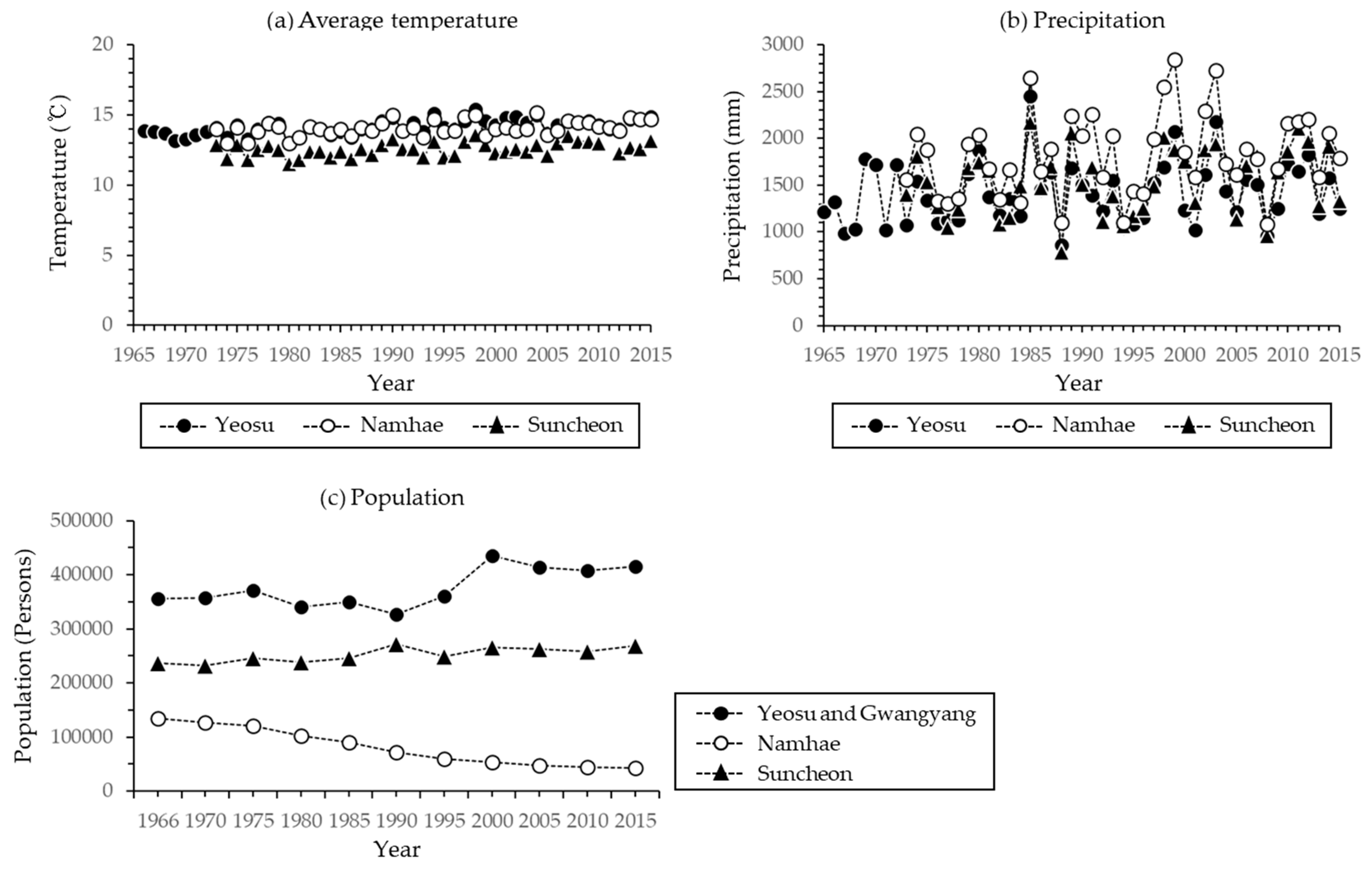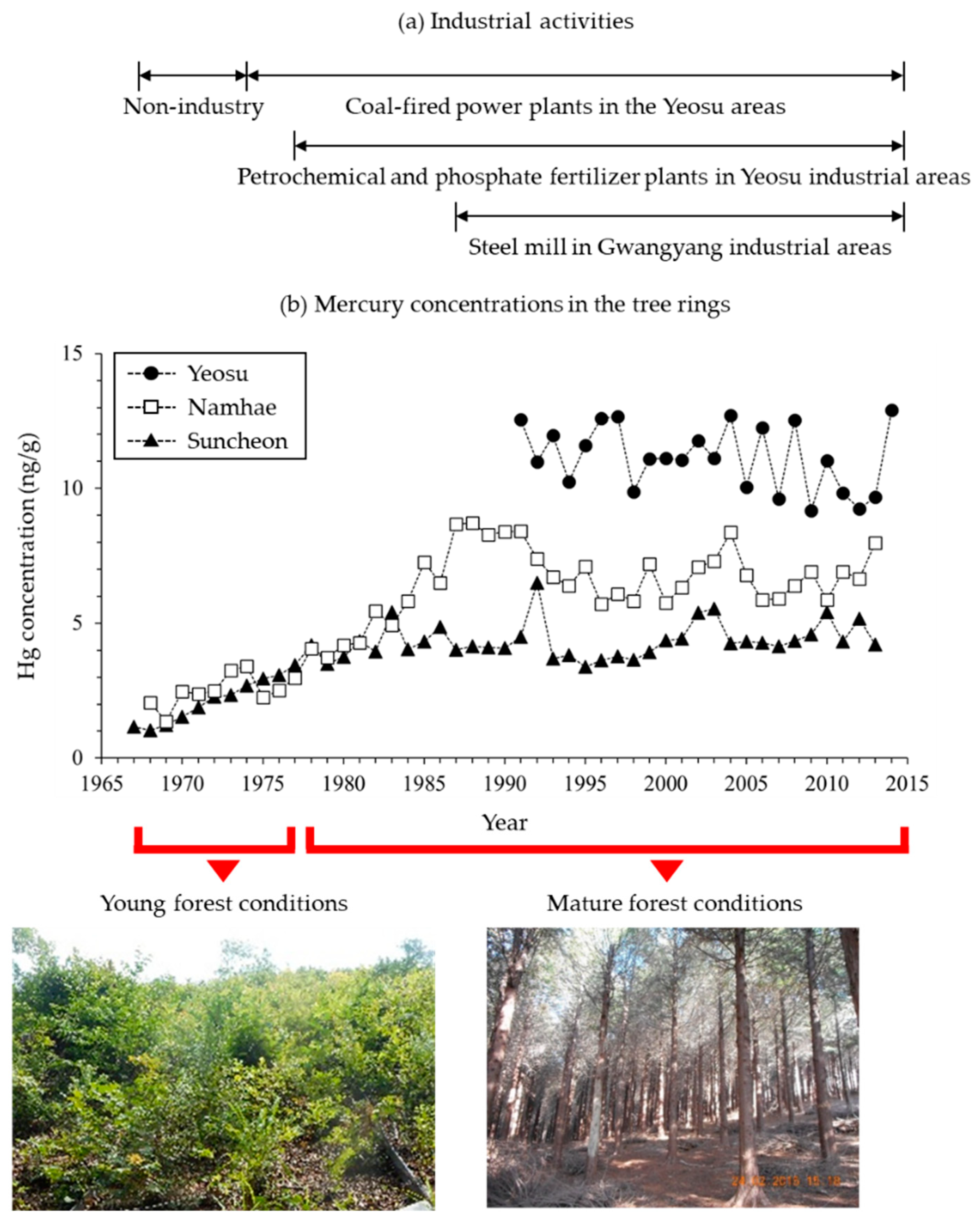Approaches to Understand Historical Changes of Mercury in Tree Rings of Japanese Cypress in Industrial Areas
Abstract
:1. Introduction
2. Materials and Methods
2.1. Study Area Description
2.2. Sampling and Sample Preparation
2.3. Mercury Analysis
2.4. Statistical Analysis
3. Results
4. Discussion
4.1. Historical Hg Recorded in Tree Rings
4.2. Spatial Distribution of Hg Concentrations in Tree Rings
5. Conclusions
Author Contributions
Funding
Acknowledgments
Conflicts of Interest
References
- Clarkson, T.W. Human toxicology of mercury. J. Trace Elem. Med. 1998, 11, 303–317. [Google Scholar] [CrossRef]
- Park, H.; Lee, K.; Moon, C.S.; Woo, K.; Kang, T.S.; Chung, E.K.; Son, B.S. Simultaneous exposure to heavy metals among residents in the industrial complex: Korean national cohort study. Int. J. Environ. Res. Public Health 2015, 12, 5905–5917. [Google Scholar] [CrossRef]
- Frescholtz, T.E.; Gustin, M.S.; Schorran, D.E.; Fernandez, G.C. Assessing the source of mercury in foliar tissue of quaking aspen. Environ. Toxicol. Chem. 2003, 22, 2114–2119. [Google Scholar] [CrossRef]
- Schroeder, W.H.; Munthe, J. Atmospheric mercury—An overview. Atmos. Environ. 1998, 32, 809–822. [Google Scholar] [CrossRef]
- Mortvedt, J.J. Heavy metal contaminants in inorganic and organic fertilizers. Fertil. Res. 1996, 43, 55–61. [Google Scholar] [CrossRef]
- Galbreath, K.C.; Zygarlicke, C.J. Mercury transformations in coal combustion flue gas. Fuel Process. Technol. 2000, 65, 289–310. [Google Scholar] [CrossRef]
- Wilhelm, S.M. Estimate of mercury emissions to the atmosphere from petroleum. Environ. Sci. Technol. 2001, 35, 4704–4710. [Google Scholar] [CrossRef] [PubMed] [Green Version]
- Nóvoa-Muñoz, J.C.; Pontevedra-Pombal, X.; Martínez-Cortizas, A.; Gayoso, E.G.-R. Mercury accumulation in upland acid forest ecosystems nearby a coal-fired power-plant in Southwest Europe (Galicia, NW Spain). Sci. Total Environ. 2008, 394, 303–312. [Google Scholar] [CrossRef] [PubMed]
- Mirlean, N.; Baisch, P.; Machado, I.; Shumilin, E. Mercury contamination of soil as the result of long-term phosphate fertilizer production. Bull. Environ. Contam. Toxicol. 2008, 8, 305–308. [Google Scholar] [CrossRef]
- Hojdová, M.; Navrátil, T.; Rohovec, J.; Žák, K.; Vaněk, A.; Chrastný, V.; Svoboda, M. Changes in mercury deposition in a mining and smelting region as recorded in tree rings. Water Air Soil Pollut. 2011, 216, 73–82. [Google Scholar] [CrossRef]
- Wang, F.; Wang, S.; Zhang, L.; Yang, H.; Gao, W.; Wu, Q.; Hao, J. Mercury mass flow in iron and steel production process and its implications for mercury emission control. J. Environ. Sci. 2016, 43, 293–301. [Google Scholar] [CrossRef] [PubMed]
- Jung, R.; Ahn, Y.S. Distribution of mercury concentrations in tree rings and surface soils adjacent to a phosphate fertilizer plant in southern Korea. Bull. Environ. Contam. Toxicol. 2017, 99, 253–257. [Google Scholar] [CrossRef] [PubMed]
- Zhou, H.; Zhou, C.; Hopke, P.K.; Holsen, T.M. Mercury wet deposition and speciated mercury air concentrations at rural and urban sites across New York state: Temporal patterns, sources and scavenging coefficients. Sci. Total Environ. 2018, 637, 943–953. [Google Scholar] [CrossRef] [PubMed]
- Dziok, T.; Grzywacz, P.; Bochenek, P. Assessment of mercury emissions into the atmosphere from the combustion of hard coal in a home heating boiler. Environ. Sci. Pollut. Res. 2019, 26, 22254–22263. [Google Scholar] [CrossRef] [Green Version]
- Huang, J.; Lyman, S.; Stamenkovic Hartman, J.; Gustin, M.S. A review of Passive sampling systems for ambient air mercury measurements. Environ. Sci. Process. Impacts 2014, 16, 374–392. [Google Scholar] [CrossRef] [PubMed]
- Zhang, L.; Qian, J.; Planas, D. Mercury concentration in tree rings of black spruce (Picea mariana Mill. B.S.P.) in boreal Quebec, Canada. Water Air Soil Pollut. 1995, 81, 81–163. [Google Scholar] [CrossRef]
- Wright, G.; Gustin, M.S.; Weiss-Penzias, P.; Miller, M.B. Investigation of mercury deposition and potential sources at six sites from the Pacific Coast to the Great Basin, USA. Sci. Total Environ. 2014, 470, 1099–1113. [Google Scholar] [CrossRef]
- Hanson, P.J.; Lindberg, S.E.; Tabberer, T.A.; Owens, J.G.; Kim, K.H. Foliar exchange of mercury vapor: Evidence for a compensation point. Water Air Soil Pollut. 1995, 80, 373–382. [Google Scholar] [CrossRef]
- Fay, L.; Gustin, M. Assessing the influence of different atmospheric and soil mercury concentrations on foliar mercury concentrations in a controlled environment. Water Air Soil Pollut. 2007, 181, 373–384. [Google Scholar] [CrossRef]
- Rea, A.W.; Keeler, G.J.; Scherbatskoy, T. The deposition of mercury in throughfall and litterfall in the Lake Champlain watershed: A short term study. Atmos. Environ. 1996, 30, 3257–3263. [Google Scholar] [CrossRef]
- Greger, M.; Wang, Y.; Neuschutz, C. Absence of Hg transpiration by shoot after Hg uptake by roots of six terrestrial plant species. Environ. Pollut. 2005, 134, 201–208. [Google Scholar] [CrossRef] [PubMed]
- Moon, I.; Cho, J.H. The chemical industry of South Korea: Progress and challenges. Chem. Eng. Prog. 2011, 107, 40–45. [Google Scholar]
- Wikipedia. Honam Coal-Fired Power Plant. Available online: https://ko.wikipedia.org/wiki/%ED%98%B8%EB%82%A8%ED%99%94%EB%A0%A5%EB%B0%9C%EC%A0%84%EC%86%8C (accessed on 1 June 2020).
- Naver encyclopedia. Yeosu Coal-Fired Power Plant. Available online: https://terms.naver.com/entry.nhn?docId=581178&cid=46631&categoryId=46631 (accessed on 1 June 2020).
- Wikipedia. Gwangyang Steel Works. Available online: https://en.wikipedia.org/wiki/Gwangyang#:~:text=Gwangyang%20Steel%20Works,-The%20Steel%20Works&text=It%20presently%20produces%20coil%20used,people%20from%20around%20the%20globe (accessed on 1 June 2020).
- Kim, J.S.; Kim, T.W. A study on the changes in forest community by air pollution at Yocheon district. J. Korean Soc. Atmos. Environ. 1986, 2, 1–10. (in Korean). [Google Scholar]
- Woo, S.Y.; Kim, D.G.; Lee, D.S. Effects of air pollution on physiological characteristics of Styrax japonica in Yeochon industrial complex. J. Korean Soc. Atmos. Environ. 2000, 16, 121–128. (in Korean). [Google Scholar]
- Korea Meteorological Administration. Weather Information. Available online: https://web.kma.go.kr/weather/main.jsp (accessed on 1 June 2020). (in Korean).
- Korean Statistical Information Service. Statistical Database with Population. Available online: http://kosis.kr/eng/index/index.do (accessed on 1 June 2020).
- Environmental Protection Agency (EPA). Method 7473: Mercury in Solids and Solutions by Thermal Decomposition, Amalgamation, and Atomic Absorption Spectrophotometry, Part of Test Methods for Evaluating Solid Waste, Physical/Chemical Methods. Available online: https://www.epa.gov/hw-sw846/sw-846-test-method-7473-mercury-solids-and-solutions-thermal-decomposition-amalgamation-and (accessed on 1 March 2020).
- Becnel, J.; Falgeust, C.; Cavalier, T.; Gauthreaux, K.; Landry, F.; Blanchard, M.; Beck, M.J.; Beck, J.N. Correlation of mercury concentrations in tree core and lichen samples in southeastern Louisiana. Microchem. J. 2004, 78, 205–210. [Google Scholar] [CrossRef]
- Risch, M.R.; DeWild, J.F.; Krabbenhoft, D.P.; Kolka, R.K.; Zhang, L. Litterfall mercury dry deposition in the eastern USA. Environ. Pollut. 2012, 161, 284–290. [Google Scholar] [CrossRef]
- Risch, M.R.; DeWild, J.F.; Gay, D.A.; Zhang, L.; Boyer, E.W.; Krabbenhoft, D.P. Atmospheric mercury deposition to forests in the eastern USA. Environ. Pollut. 2017, 228, 8–18. [Google Scholar] [CrossRef]
- Wang, X.; Bao, Z.; Lin, C.J.; Yuan, W.; Feng, X. Assessment of global mercury deposition through litterfall. Environ. Sci. Technol. 2016, 50, 8548–8557. [Google Scholar] [CrossRef]
- Yu, X.; Driscoll, C.T.; Warby, R.A.; Montesdeoca, M.; Johnson, C.E. Soil mercury and its response to atmospheric mercury deposition across the northeastern United States. Ecol. Appl. 2014, 24, 812–822. [Google Scholar] [CrossRef] [Green Version]
- Godbold, D.L.; Hutterman, A. Inhibition of photosynthesis and transpiration in relation to mercury-induced root damage in spruce seedlings. Physiol. Plant. 1988, 74, 270–275. [Google Scholar] [CrossRef]
- Wängberg, I.; Munthe, J.; Pirrone, N.; Iverfeldt, Å.; Bahlman, E.; Costa, P.; Ebinghaus, R.; Feng, X.; Ferrara, R.; Gardfeldt, K.; et al. Atmospheric mercury distribution in Northern Europe and in the Mediterranean region. Atmos. Environ. 2001, 35, 3019–3025. [Google Scholar] [CrossRef]



| Site | Distance from the Industry Area (km) | Hg Concentration (ng/g) | ||
|---|---|---|---|---|
| 1967–1977 | 1978–2014 | |||
| Yeosu | Gwangyang | Average ± SD (Median) | Average ± SD (Median) | |
| Yeoau | 4 | 12 | - | 11.15 ± 1.21 (11.10) a |
| Namhae | 26 | 33 | 2.51 ± 0.59 (2.47) | 6.54 ± 1.32 (6.57) b |
| Suncheon | 40 | 38 | 2.15 ± 0.84 (2.27) | 4.34 ± 0.66 (4.23) c |
© 2020 by the authors. Licensee MDPI, Basel, Switzerland. This article is an open access article distributed under the terms and conditions of the Creative Commons Attribution (CC BY) license (http://creativecommons.org/licenses/by/4.0/).
Share and Cite
Ahn, Y.S.; Jung, R.; Moon, J.-H. Approaches to Understand Historical Changes of Mercury in Tree Rings of Japanese Cypress in Industrial Areas. Forests 2020, 11, 800. https://doi.org/10.3390/f11080800
Ahn YS, Jung R, Moon J-H. Approaches to Understand Historical Changes of Mercury in Tree Rings of Japanese Cypress in Industrial Areas. Forests. 2020; 11(8):800. https://doi.org/10.3390/f11080800
Chicago/Turabian StyleAhn, Young Sang, Raae Jung, and Jae-Hyun Moon. 2020. "Approaches to Understand Historical Changes of Mercury in Tree Rings of Japanese Cypress in Industrial Areas" Forests 11, no. 8: 800. https://doi.org/10.3390/f11080800





